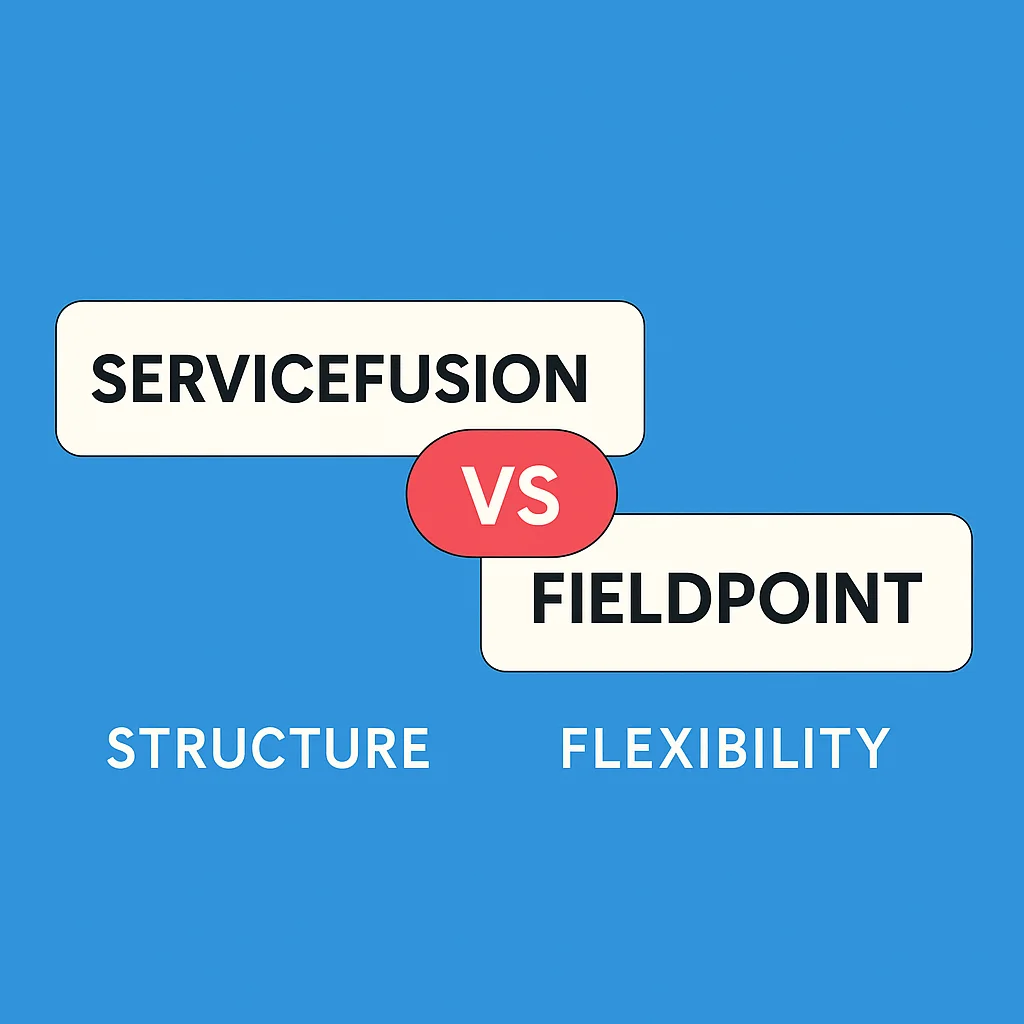Empowering small businesses to succeed
Whether youre a small startup, a growing mid-market company, or a large enterprise — our field service solutions adapt to your operational needs. From flexible service workflows to scalable tools for technicians and dispatchers, we help you optimize processes, improve response times, and deliver consistent service quality.

In the world of Field Service Management, two main philosophies coexist: strict structure and living flexibility. These are exactly the two directions embodied by ServiceFusion and FieldPoint.
ServiceFusion represents the classic model of structured systems — clear hierarchy, layered access, defined roles, strict statuses, analytics, reports, and complex operational chains. It’s software discipline, almost military in nature. FieldPoint, on the other hand, is a living tool — flexible, dynamic, and close to the ground. Processes can be changed on the fly, and checklists or workflows adjusted without technical knowledge.
At first glance, they seem like opposites. But businesses rarely have the luxury of choosing between stability and adaptability. In reality, they need both. And that’s where Shifton enters — a platform built on the same logic as real service businesses: not structure versus flexibility, but structure for the sake of flexibility.
System Logic
ServiceFusion is structure in its purest form. The system is designed for control and accountability. Every action becomes a document, every task — a data object, every report — a KPI for analysis.
FieldPoint, meanwhile, works “in the moment.” It’s made for those who value speed and motion. A manager can modify a task in progress, and a technician can close a job from their phone with photos attached.
Shifton creates a logical middle ground. It allows structure — roles, statuses, zones, reports — without turning work into a chain of bureaucratic clicks. Everything lives on one panel: map, tasks, teams, history. Work doesn’t require switching between a dozen screens.
Implementation and Training
ServiceFusion needs to be implemented. Without preparation, users often feel lost: too many settings, roles, dependencies. On average, companies spend up to a week just understanding the interface.
FieldPoint is easier but less predictable. The “set it as you go” logic helps to start quickly but makes it hard to maintain standards as the company grows.
Shifton is deployed in hours. Registration, adding employees, setting up zones and roles — and the system is ready. No lengthy instructions, no onboarding projects, just intuitive logic of actions.
Functionality and Depth
ServiceFusion provides a powerful suite of tools — planning, CRM, inventory, reporting, routing, and client management. But it’s built around corporate logic. A regular manager might struggle to see something simple — like who’s on-site right now.
FieldPoint is simple, but therefore limited. It covers basic needs but lacks management depth.
Shifton keeps the balance: everything essential is there — tasks, routes, reports, checklists — yet the interface stays light. There are no redundant “checkbox” features. Every module serves a real purpose, not marketing.
Team Architecture
ServiceFusion enforces a strict hierarchy:
leader → manager → technician.
Every action is confirmed from above. This is ideal for large organizations but heavy for teams of 10–30 people.
FieldPoint, by contrast, has no rigid structure. Any employee can edit a task, a manager can close a job, and a technician can add a client. It’s convenient but chaotic.
Shifton solves this architecturally. Roles are flexible yet defined: Owner, Admin, Requester, Approver, Technician. Everyone sees only what they need. The system records all actions — without unnecessary micromanagement.
Geolocation and Task Control
ServiceFusion uses GPS, but as a secondary function. FieldPoint also offers maps, but performance drops when many employees are active.
Shifton makes geolocation the control center. The map displays all active tasks; each employee is a moving point, and each job request is a line connecting client and technician. You instantly see who’s closest, who can take an urgent call, and how long travel took — no “where are you?” calls needed.
Automation
ServiceFusion builds rules. FieldPoint relies on people.
Shifton automates actions, not entire processes. Each workflow is built through statuses and checklists — “assigned → in progress → completed → verified.” If an employee is delayed, the system notifies the manager. When a job is finished, the checklist becomes a report. It’s automation that helps, not replaces, human involvement.
Analytics and Reports
ServiceFusion loves numbers — charts, exports, Excel sheets. FieldPoint offers simple but shallow statistics.
Shifton integrates analytics directly into the interface. It doesn’t live “in reports” — it’s part of every screen. You can instantly see how many tasks were completed today, who’s overloaded, and where delays are occurring. It’s real-time transparency for real decisions.
Scale and Stability
ServiceFusion targets large enterprises. FieldPoint fits local teams.
Shifton is stable in both worlds. It scales without strain — you can add branches, regions, even languages — with no drop in performance. That’s crucial when your business grows not by plan, but by necessity.
Support and Updates
ServiceFusion updates rarely, with large releases. FieldPoint responds slowly to feedback.
Shifton updates every two to three weeks — small, meaningful improvements. Bugs are fixed fast, and new features appear based on user requests. Shifton’s support acts as an engaged partner — not just responding, but helping you find solutions.
Value
ServiceFusion is reliable but heavy. FieldPoint is light but limited. Shifton is mature yet effortless.
It gives you the same discipline as ServiceFusion and the same flexibility as FieldPoint — without forcing you to choose.
Shifton is the place where structure doesn’t kill flexibility — it makes it controllable.

 English
English  Español
Español  Português
Português  Deutsch
Deutsch  Français
Français  Italiano
Italiano  日本語
日本語  中文
中文  हिन्दी
हिन्दी  עברית
עברית  العربية
العربية  한국어
한국어  Nederlands
Nederlands  Polski
Polski  Türkçe
Türkçe  Українська
Українська  Русский
Русский  Magyar
Magyar  Română
Română  Български
Български  Čeština
Čeština  Ελληνικά
Ελληνικά  Svenska
Svenska  Dansk
Dansk  Norsk
Norsk  Suomi
Suomi  Bahasa
Bahasa  Tiếng Việt
Tiếng Việt  Tagalog
Tagalog  ไทย
ไทย  Latviešu
Latviešu  Lietuvių
Lietuvių  Eesti
Eesti  Slovenčina
Slovenčina  Slovenščina
Slovenščina  Hrvatski
Hrvatski  Македонски
Македонски  Қазақ
Қазақ  Azərbaycan
Azərbaycan  Afrikaans
Afrikaans  বাংলা
বাংলা